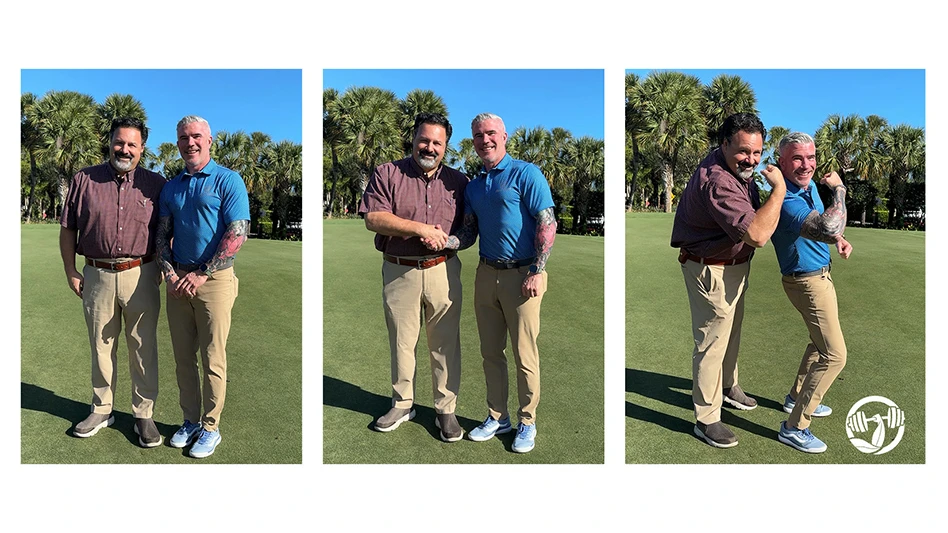
Guy Cipriano (4)
Dig deep enough, think long enough, and you can link any two golf courses you want. Augusta National Golf Club and Augusta Municipal Golf Course? Connected by far more than a ZIP code. Pine Valley Golf Club and Pine Needles Lodge & Golf Club? Probably more similar than you might think. Eagle Lake Golf Course in Utah and Eagle Lakes Golf Course in Texas and Eagle Lakes Golf Club in Florida? The evidence is certainly somewhere.
And so, finding everything that connects The Olde Farm in Bristol, Virginia, and the Pete Dye River Course of Virginia Tech a hundred miles and change right up the road is not only possible but practically required after visiting both.
Yes, The Olde Farm is tucked inland, filled with hills and elevation change, and is among the more private and prestigious courses in the country, while the River Course hugs miles of New River shoreline, is practically pancake flat — every undulation made by humans almost 30 years ago — and is open to all. But they share a state. They just about share a road, with 85 of the 102 miles that separate them an easy drive along Interstate 81. And, perhaps no surprise given the climate, they are both covered in bentgrass.
Most important, the men tasked with caring for each of them share a history.
Josh Pope and Greg Caldwell were working at The Greenbrier in June 2016 when an historic storm rumbled in, spilling water over West Virginia, pushing up Howard’s Creek, flooding the property, and shifting the paths of so many lives.
Pope was superintendent then of The Old White under director of golf course maintenance Kelly Shumate. Caldwell was 17 days into working directly under Pope as assistant superintendent of that course. The destruction and tragedy they endured, and the recovery they worked through and helped spur on, will link them far more than just a couple hours’ drive down the highway.
Pope moved directly from The Greenbrier to The Olde Farm in May 2018. He did not always want to maintain golf courses.
When he started at the University of Georgia in the fall of 1997, he was actually an accomplished upright bass player and a music therapy major, but he realized rather quickly that, “I didn’t want to practice five to six hours a day,” he says. So, he switched to equine veterinary, a seemingly strong choice until he opened a freezer one day during course work and discovered a variety of disembodied horse legs and heads.
He switched gears one more time, to turfgrass management. The odds of discovering horse parts on a golf course, though mathematically possible, were far less likely.
Internships at Reynolds Lake Oconee and Ridgewood (New Jersey) Country Club yielded assistant superintendent positions at Oakmont Country Club, The International Golf Club and Resort, and Pikewood National Golf Club before he landed at The Greenbrier in October 2014. “It’s been a lot of hard work, I won’t deny that,” he says. “I think I’m finally starting to realize, in Year 43, that there’s a balance.”
Part of that balance comes from roaming the incredible grounds of what is quite literally an old tobacco farm with his friendly English bulldog Sanford — named after the home of Pope’s beloved Georgia Bulldogs football team, which itself is named after Dr. Steadman Sanford, a former school president who was key in building up its athletics program — and part of it comes just from the wisdom of time.
Pope is deep enough into his career that he knows what he wants and what needs to be done on and off the course. He put that wisdom to good use in planning and designing The Olde Farm’s 22,000-square-foot maintenance area, a multi-building gem designed to inspire crew members, streamline processes, and maximize an incredible place.


Inside, the men’s locker room includes 31 lockers and the women’s locker room, though a bit smaller, is a win just for being there. The break room includes seven tables and 45 chairs for a crew that has numbered around 19 most of this season. Offices are clean and uncluttered. Equipment is organized as if Martha Stewart had worked with Marie Kondo. Plant protectants are organized not just by company but alphabetized by product name. Outside, sand sits in bays whose roofs were designed high enough for dozers to scoop in and out. Parking areas are wide enough for any Gator or golf car to execute a U-turn. “I did what I felt was necessary for this club,” Pope says.
All this to care perfectly for 161 acres of land that includes 55 acres of bentgrass and features 4½ acres of greens, 2½ acres of tees, and two acres of an incredibly fun cross-country, play-as-you-wish short course. One of the greens, for some reason, is called Buried Souls.
Pope knows what he needs — that is very clear — and what he wants. Perhaps the only thing he wants that might be out of reach is a return to his upright bass. He last played it as a freshman in Athens.
“I wiped my hands clean,” he says. “Probably wish I hadn’t.”
Caldwell, meanwhile, moved to an assistant superintendent position at The Highlands Course at Primland — another Virginia powerhouse — before starting at the River Course in July 2020.
A Virginia Tech alum, he ventured to Texas to work parts of three seasons as an assistant superintendent at Colonial Country Club in Fort Worth before returning a little closer to home at The Greenbrier. His timing was auspicious: Thinking his work would include tournament prep every summer for what was then called The Greenbrier Classic, he was in his third week at the West Virginia resort when disaster hit and work shifted to nearly a year of cleaning up and rebuilding.
His nearly three years at the River Course have been far less chaotic. He spots trains running on the other side of the New River, which runs next to the course for more than 2½ miles, and sometimes sees boats in the water. Bald eagles and nearby military jets on training runs share the sky overhead. During the summer, he might sneak away for a minute to grab a handful of the raspberries that litter the slopes along the front nine. “They’re so good,” Caldwell says.
The River Course was not originally designed by Dye. A home developer built it back in 1998 — when Caldwell was still six years from starting at Virginia Tech — and the school acquired it only in 2004, when it called in Dye for a renovation.
Dye never worked on the best land, but he almost always made the most of what he had. The River Course remains relatively flat and, 81 feet below the clubhouse, is not far above the waterline. Once part of an 800-acre property, the course now covers about 100 acres. The front nine sits north of the clubhouse, the back nine sits south, and the maintenance facility — smaller than what Pope designed across the state — is down by the 10th tee. “It can take a long time to get to some spots,” Caldwell says. Greens, tees, and fairways are L-93 creeping bentgrass; the rough is, as Shumate once described such stuff to Caldwell, a “Heinz 57” mix.
Caldwell opened up the shore during the 2021-22 winter, when he cut down trees that separated the course from the water. Hard, physical work for Caldwell and his crew of nine, and he rented a chipper only after he finished clearing everything. “Hey,” he says with a laugh, “that chipper was expensive.”



Part of the crew these days is Greg Osborne, like Caldwell a graduate of Narrows High School, located about 35 miles northwest of the course. The two were friends as teenagers and when Caldwell posted on his personal Facebook page that he was in need of an equipment technician, Osborne replied. Turns out Osborne, a Honda engine-certified mechanic, had been working on boats and was looking for a bit of a change.
Caldwell says the course — which is the home of the men’s and women’s golf teams of both Virginia Tech and Radford University — is a “work in progress,” with “a lot still to do,” but it looked fantastic on an early spring afternoon. Come back in the fall, when the colors are popping and the Hokies are (with any luck) winning again on the gridiron, and it will be in full, wonderful swing.
Matt LaWell is Golf Course Industry’s managing editor.
WANT MORE?
Enter your email to receive our newsletters.
Latest from Golf Course Industry
- Kerns featured in Envu root diseases webinar
- Toro continues support of National Mayor’s Challenge for Water Conservation
- A different kind of long distance
- Golf Construction Conversations: Stephen Hope
- EnP welcomes new sales manager
- DLF opening centers in Oregon, Ontario
- Buffalo Turbine unveils battery-powered debris blower
- Beyond the Page 66: Keep looking up





